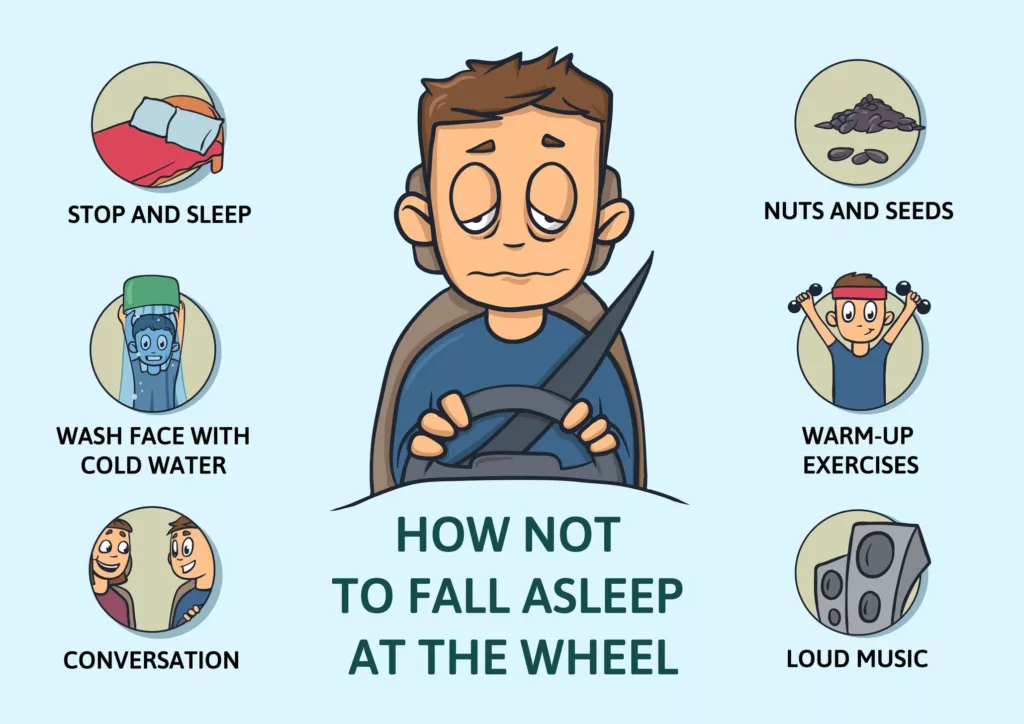How to Overcome Driver Fatigue
When you don’t get enough or good quality sleep, you can become tired. Driver Fatigue has the same effect as driving under the influence of alcohol. According to a NIOSH poll, 37% of workers get less than the recommended minimum of 7 hours of sleep. Driving is a vital part of our daily lives. So it is important to adopt safe driving practices. So on and off the job, excellent sleep habits are critical to your health and safety. You may be more prone to fatigue at work if your job requires long hours of work or driving, shiftwork, or a long commute. According to the NHTSA, sleep-deprived driving results in over 6500 deaths on American roads and highways.
What Causes Driver Fatigue?
There are several reasons behind driver fatigue. Some of the reasons are:
- Being awake for extended periods.
- Not getting enough sleep over several days.
- Time of day. Your body has a sleep/wake cycle that indicates when you should be awake and when you should sleep. The strongest desire to sleep occurs in the early morning hours, when you are most prone to driver fatigue.
- Long durations of inaction or monotonous work.
- Sleep disorders or medicines that cause sleepiness.

Effects of Fatigue
Driver fatigue manifests itself in the following ways:
- Sleeping while driving.
- Slower reaction time to changing road conditions, other cars, or pedestrians.
- Making bad driving decisions.
- Straying away from your lane.
- Going through “Tunnel Vision” when your mind stops concentrating on your surroundings.
- Having “Microsleeps” when you go to sleep for short bursts of 30 seconds or less.
- Not remembering the last few miles of your journey.
How to Plan a Safe Trip
Before starting a long road trip, it is important to plan ahead to prevent driver fatigue. Before driving, make sure you’ve had enough sleep. Most of us require 7 to 9 hours of sleep per day. If you’re tired, don’t drive until you get some rest, or find another mode of transportation. Make a mental map of your route, with planned breaks every 2 hours at the very least.
Recognize the early indicators of driver fatigue, such as frequent yawning, changing positions frequently, and frequent eye blinks. Do not drive if you are unable to keep your eyes open, you start nodding your head or you can’t recall a portion of your journey. These are all symptoms that you are already very tired, or are experiencing microsleeps, and are therefore unsafe to drive.
Don’t be tempted to keep driving to get to your destination quickly. Schedule your breaks and take more if necessary. Keeping alert by opening the window or turning up the music is ineffective. Pullover and take a rest as soon as you start to display signs of tiredness, such as yawning.
You should take a break if you are feeling tired when driving. Park somewhere safe and take a short nap after locking the doors. When you wake up, take a 10-minute walk outside before getting back on the road. You may also have some coffee to increase your energy levels. Taking these steps will allow you to drive safely for at least a couple of hours.

Preventing Driver Fatigue at Work
Most people are aware of the hazards associated with driver fatigue. The government regularly runs media campaigns raising awareness about safe driving practices. They have also installed rumble strips on highways to alert inattentive drivers. Car manufacturers are now also offering crash avoidance technologies in their vehicles. However, the government and carmakers can only do so much. The onus of safe driving ultimately falls on the driver sitting behind the steering wheel. Both employers and employees can take several measures to protect themselves from driver fatigue.
Employers:
- Implement policies that limit overtime and the number of consecutive shifts that can be worked.
- Ensure that adequate staffing numbers are in place across all operations.
- Provide sleep health and tiredness management training to your employees.
- Implement a sleep problem screening and management programme in the workplace.
- Allow time for rest breaks and naps throughout long shifts.
- Provide fatigue symptom checklists to supervisors and employees, and encourage self-reporting.
- Encourage coworkers to keep track of each other’s fatigue symptoms.
- Analyze data from in-vehicle monitoring systems to look for indicators of weariness, such as lane deviations.
- Consider employing wearables to track driver weariness, such as an instrumented wristband.
Employees
- Get enough rest (7-9 hours daily). If you’re still tired after getting enough sleep, get yourself checked for any health issues that could be influencing your sleep.
- Plan your activities outside of work so that you have ample time to sleep.
- Make your sleeping environment conducive to good sleep: a dark, calm, cold room free of electronics.
- Pull over, sip a cup of coffee, and take a 15-30 minute nap before continuing if you’re tired while driving. The effects are just transitory, and sleep is the only “cure” for exhaustion.
- Keep an eye out for indicators of exhaustion in yourself and your coworkers.
- Report incidents of exhaustion in yourself and others to your immediate supervisor, who will be able to assist you in determining the best course of action.
- If you’re questioned about a fatigue-related incident, tell the truth. Fatigue is a natural biological response, not a reflection of your work performance.
- Educate yourself on driver fatigue.





